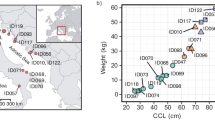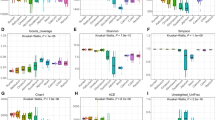Abstract
Diazotrophic gut symbionts are considered to act as nitrogen providers for their hosts, as was shown for various termite species. Although the diet of lagomorphs, like pikas or rabbits, is very poor in nitrogen and energy, their fecal matter contains 30–40% of protein. Since our hypothesis was that pikas maintained a diazotrophic consortium in their gastrointestinal tract, we conducted the first investigation of microbial diversity in pika guts. We obtained gut samples from animals of several Ochotona species, O. hyperborea (Northern pika), O. mantchurica (Manchurian pika), and O. dauurica (Daurian pika), in order to retrieve and compare the nitrogen-fixing communities of different pika species. The age and gender of the animals were taken into consideration. We amplified 320-bp long fragments of the nifH gene using the DNA extracted directly from the colon and cecum samples of pika’s gut, resolved them by DGGE, and performed phylogenetic reconstruction of 51 sequences obtained from excised bands. No significant difference was detected between the nitrogen-fixing gut inhabitants of different pika species. NifH sequences fell into two clusters. The first cluster contained the sequences affiliated with NifH Cluster I (Zehr et al., 2003) with similarity to Sphingomonas sp., Bradyrhizobium sp., and various uncultured bacteria from soil and rhizosphere. Sequences from the second group were related to Treponema sp., Fibrobacter succinogenes, and uncultured clones from the guts of various termites and belonged to NifH Cluster III. We suggest that diazotrophic organisms from the second cluster are genuine endosymbionts of pikas and provide nitrogen for further synthesis processes thus allowing these animals not to be short of protein.
Similar content being viewed by others
References
Brett, C.T. and Waldron, K., Physiology and Biochemistry of Plant Cell Walls, London: Unwin Hyman, 1990, 194 p.
Van Soest, P.J., Nutritional Ecology of the Ruminant, 2nd ed., Ithaca, NY: Comstock Publishing Associates, 1994, 476 p.
Russell, J.B., Rumen Microbiology and Its Role in Ruminant Nutrition, New York: Ithaca, 2002, 119 p.
Clark, J.H., Klusmeyer, T.H., and Cameron, M.R., Microbial protein synthesis and flows of nitrogen fractions to the duodenum of dairy cows, J. of Dairy Science, 1992, vol. 75, pp. 2304–2323.
Wood, T.G. and Johnson, R.A., The Biology, physiology and ecology of termites, in Economic Impact and Control of Social Insects, Vinson, S.B., Ed., New York: Praeger Publications, 1986, pp. 1–68.
Noirot, C., From Wood- to Humus-feeding: an important trend in termite evolution, in Biology and Evolution of Social Insects, Billen, J., Ed., Leuven: Leuven University Press, 1992, pp. 107–119.
Slaytor, K., Cellulose digestion in termites and cock-roaches: what role do symbionts play?, Comp. Biochem. Physiol., 1992, vol. 103B, pp. 775–784.
Benemann, J.R., Nitrogen fixation in termites, Science, 1973, vol. 181, pp. 164–165.
Noda, S., Ohkuma, M., Usami, R., Horikoshi, K., and Kudo, T., Culture independent characterization of a gene responsible for nitrogen fixation in the symbiotic microbial community in the gut of the termite Neotermeskoshunensis, Appl. Environ. Microbiol., 1999, vol. 65, pp. 4935–4942.
Brauman, A., Doré, J., Eggleton, P., Bignell, D., Breznak, J.A., and Kane, M.D., Molecular phylogenetic profiling of prokaryotic communities in guts of termites with different feeding habits, FEMS Microbiol Ecol., 2001, vol. 35, pp. 27–36.
Hiracawa, H., Supplement: coprophagy in leporids and other mammalian herbivores, Mammal Rev., 2002, vol. 32, pp. 150–152.
Eden, A., Coprophagy in the rabbit: origin of night feces, Nature, 1940, vol. 145, pp. 628–629.
Pshennikov, A.E., Alekseev, V.G., Koryakin, I.I., and Gnutov, D.Yu., Coprophagy in northern pika Ochotona hyperborea from Yakutia, Zoologicheskii zhurnal, 1990, vol. 69, pp. 106–114 (in Russian).
Langer, P., The Digestive tract and life history of small mammals, Mammal Rev., 2002, vol. 32, pp. 107–131.
Braun, S.T., Proctor, L.M., Zani, S., Mellon, M.T., and Zehr, J.P., Molecular evidence for zooplankton-associated nitrogen-fixing anaerobes based on amplification of the nifH gene, FEMS Microbiol. Ecol., 1999, vol. 28, pp. 273–279.
Formozov, N.A. and Baklushinskaya, I.Yu., Manchurian pika (Ochotona mantchurica scorodumovi) from the interfluve of the shilka and argun rivers: karyotype and problems of pika taxonomy in amurland and adjacent territories, Zoologicheskii zhurnal, 2011, vol. 90, pp. 490–497 (in Russian).
Poly, F., Monrozier, L.J., and Bally, R., Improvement in the RFLP procedure for studying the diversity of nifH genes in communities of nitrogen fixers in soil, Res. Microbiol., 2001, vol. 152, pp. 95–103.
Wartiainen, I., Eriksson, T., Zheng, W., and Rasmussen, U., Variation in the active diazotrophic community in rice paddy — nifH PCR-DGGE analysis of rhizosphere and bulk soil, Appl. Soil Ecol., 2008, vol. 39, pp. 65–75.
Muyzer, G., de Waal, E.C., and Uitterlinden, A.G., Profiling of complex microbial populations by denaturing gradient gel electrophoresis analysis of polymerase chain reaction-amplified genes coding for 16S rRNA, Appl. Environ. Microbiol., 1993, vol. 59, pp. 695–700.
Hall, T.A., BioEdit: a User-friendly biological sequence alignment editor and analysis program for Windows 95/98/NT, Nucl. Acids Symp. Ser., 1999, vol. 41, pp. 95–98.
Van de Peer, Y. and De Wachter, Y., TREECON for Windows: a software package for the construction and drawing of evolutionary trees for the Microsoft Windows environment, Comput. Applic. Biosci., 1994, vol. 10, pp. 569–570.
Zehr, J.P., Jenkins, B.D., Short, S.M., and Steward, G.F., Nitrogenase gene diversity and microbial community structure: a crosssystem comparison, Environ. Microbiol., 2003, vol. 5, pp. 539–554.
Hamilton, T.L., Boyd, E.S., and Peters, J.W. Environmental constraints underpin the distribution and phylogenetic diversity of nifh in the yellowstone Geothermal Complex, Microb Ecol., 2011, vol. 61, pp. 860–870.
Hery, M., Philippot, L., Meriaux, E., Poly, F., Le Roux, X., and Navarro, E., Nickel mine spoils revegetation attempts: effect of pioneer plants on two functional bacterial communities involved in the n-cycle, Environ. Microbiol., 2005, vol. 7, pp. 486–498.
Sleat, R., Mah, R., and Robinson, R., Isolation and Characterization of an anaerobic, cellulolytic bacterium, Clostridium cellulovorans sp. nov., Appl. Environ. Microbiol., 1984, vol. 48, pp. 88–93.
Evans, N., Brown, J., Murray, R., Getty, B., Birtles, R., Hart, C., and Carter, S., Characterization of novel bovine gastrointestinal tract Treponema isolates and comparison with bovine digital dermatitis treponemes, Appl. Environ. Microbiol., 2011, vol. 77, pp. 138–147.
Stewart, C.S. and Flint, H.J., Bacteroides (Fibrobacter) succinogenes, a cellulolytic anaerobic bacterium from the gastrointestinal tract, Appl. Microbiol. Biotechnol., 1989, vol. 30, pp. 433–439.
Yamada, A., Inoue, T., Noda, S., Hongoh, Y., and Ohkuma, M., Evolutionary trend of phylogenetic diversity of nitrogen fixation genes in the gut community of wood-feeding termites, Mol. Ecol., 2007, vol. 16, pp. 3768–3777.
Ohkuma, M. and Kudo, T., Phylogenetic diversity of the intestinal bacterial community in the termite Reticulitermes speratus, Appl. Environ. Microbiol., 1996, vol. 62, pp. 461–468.
Hume, I., Optimal digestive strategies in mammalian herbivores, Physiol. Zool., 1989, vol. 62, pp. 1145–1163.
Ley, R.E., Hamady, M., Lozupone, C., Turnbaugh, P.J., Ramey, R.R., Birche, J.S., Schlegel, M.L., Tucker, T.A., Schrenzel, M.D., Knight, R., and Gordon, J.I., Evolution of mammals and their gut microbes, Science, 2008, vol. 320, pp. 1647–1651.
McBee, R., Hindgut fermentations in nonavian species, J. Exp. Zool. Suppl., 1989, vol. 3, pp. 55–60.
Ritchie, M.E. and Tilman, D., Responses of legumes to herbivores and nutrients during succession on a nitrogen poor soil, Ecology, 1995, vol. 76, pp. 2648–2655.
Piknova, M., Guczynska, W., Miltko, R., Javorsky, P., Kasperowicz, A., Michalowski, T., and Pristas, P., Treponema zioleckii sp. nov., a novel fructan-utilizing species of rumen treponemes, FEMS Microbiol. Lett., 2008, vol. 289, pp. 166–172.
McBee, R.H. and McBee, V., The hindgut fermentation in the green iguana, Iguana iguana, in Iguanas of the World, Burghardt, G.M. and Rand, A.S., Eds. Noyes, Park Ridge, New Jersey, 1983, pp. 77–83.
Hongoh, Y., Deevong, P., Inoue, T., Moriya, S., Trakulnaleamsai, S., Ohkuma, M., Vongkaluang, C., Noparatnaraporn, N., and Kudo, T., Intra- and interspecific comparisons of bacterial diversity and community structure support coevolution of gut microbiota and termite host, Appl. Environ. Microbiol., 2005, vol. 71, pp. 6590–6599.
Marusina, A.I., Boulygina, E.S., Kuznetsov, B.B., Tourova, T.P., Kravchenko, I.K., and Gal’chenko, V.F., A system of oligonucleotide primers for amplifying nifH genes from various taxonomic groups of prokaryotes, Microbiology, 2001, vol. 70, no. 1, pp. 86–91.
Sarita, S., Priefer, U.B., Prell, J., and Sharma, P.K., Diversity of nifH gene amplified from rhizosphere soil DNA, Curr. Sci., 2008, vol. 94, pp. 109–115.
Mehta, M.P., Butterfield, D.A., and Baross, J.A., Phylogenetic diversity of nitrogenase (nifH) genes in deep-sea and hydrothermal vent environments of the Juan de Fuca Ridge, Appl. Environ. Microbiol., 2003, vol. 69, pp. 960–970.
Rösch, C., Mergel A., and Bothe, H., Biodiversity of denitrifying and dinitrogen-fixing bacteria in an acid forest soil. Appl. Environ. Microbiol., 2002, vol. 68, pp. 3818–3829.
Author information
Authors and Affiliations
Corresponding author
Additional information
The article is published in the original.
Rights and permissions
About this article
Cite this article
Kizilova, A.K., Kravchenko, I.K. Diversity of diazotrophic gut inhabitants of pikas (Ochotonidae) revealed by PCR-DGGE analysis. Microbiology 83, 288–295 (2014). https://doi.org/10.1134/S0026261714010068
Received:
Published:
Issue Date:
DOI: https://doi.org/10.1134/S0026261714010068




